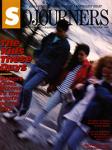As the feel-good communitarians at U.S.A. Today would put it, "we" (i.e. Americans) are becoming more self-conscious and comfortable about our identity as the world's first video republic. It's now difficult to recall that in 1960, during the first, real made-for-TV presidential campaign, pundits were aghast at the fact that Dick Nixon's sweaty forehead and 5 o'clock shadow might actually affect the outcome of an election. Today, analysis of a candidate's TV persona is central to the substance of political reporting, and no one bats an eye.
The George Bush-Dan Rather showdown of January 25 was front-page news in the daily papers. Time was when that confrontation would have been written off as a "media event" of little consequence to a story in which investigations are ongoing and indictments and trials forthcoming. But now we've made our peace with the fact that media events are events. As usual, the experts are way behind much of the populace in this regard. For that evergrowing number of Americans who've bought home video cameras, the most mundane happenings of their own daily lives are media events.
The Rather-Bush battle came hot on the heels of a round of discussion occasioned by the release of the film Broadcast News. That film represents another step in the consolidation of video self-consciousness and demystification. You get to see network news being made, and, like a sausage factory, it's not always a pretty sight.
But again the professional media-watchers seem to lag behind the living-room amateurs. Central to the film's plot and point is a piece of news-staging that is supposed to be taken as a horrendous breech of journalistic ethics. But I have a feeling that the average movie-goer reacted to the incident with a big "So what?" It's a safe bet that most viewers already assume they'll be subject to staged reaction shots, and worse, that this is part of the TV news stock in trade.
As NBC's Bob Abernethy attests (in his review on the previous pages), public cynicism in this case even outstrips reality. There are still some standards in the network news divisions. Dan Rather demonstrated that when he took on the vice president. But there is no easy or obvious way back to the days when the viewing public believed it.
The problem for TV news lies in the very nature of the medium. The TV experience, and the whole video way of life, has raised our level of immunity to artifice. We instinctively see through stagy self-presentation and pretense precisely because we've absorbed so much of it.
Meanwhile, TV news clings steadfastly to its artifice as an omniscient, self-contained universe of official reality. The anchor occupies a seat of authority behind an imposing desk and leads us in and out of a series of "stories," each with a beginning, middle, and end. The half-hour taken as a whole has its own dramatic structure.
We're eased in and out of situations of tragedy or tension with a soothing tone of voice or, increasingly, with the light relief of a human interest story. At the end we're expected to leave with a feeling of completeness, or at least closure. Walter Cronkite has retired, but the various anchor sign-offs still summon the echo of "That's the way it is."
BUT WE ALL KNOW that's not the way it is. We know that the whole production was staged, edited, and manipulated. Even before Broadcast News, most of us knew that someone was whispering in the anchor's ear and that the scene during the commercials was like that backstage between acts of a play.
One half an hour of TV news can't tell us "how it is." It's a production, a reality-based soap opera. It served a function when viewers swallowed the artifice in blissful ignorance and thus also imbibed at least some nuggets of information. But we're hip to that now, and, as a result, we take the news on its own terms, as a performance, and reflexively analyze it as such.
The answer isn't just a longer news show or more context, background, and in-depth discussion. The MacNeil-Lehrer Newshour essentially embodies the highbrow view of what TV news should look like. And it's dull, dull, dull. My guess is that the best direction for TV news to take would be to declare war on artifice and pretension.
Tear down the sets. Let the cables and cameras show and the background chatter of the news room be heard. Show us the teleprompter. Take away the desk and put the anchor in a folding chair. Have the reporters explain stories conversationally, with reference to their own subjective experience of the events. Have them argue with each other and with the newsmakers. Nurture eccentricity. Look for balance, in viewpoint and subject matter, over the course of a week, or a month, and not in every half hour, or every three minutes. If people want to hear a comprehensive reading of the day's wire-service copy, they should have access to CNN.
Above all, TV news should give up the pose of objective omniscience. In print, one can be, or convincingly pretend to be, a detached, god-like expert observer. But TV is a conversation between performer and viewer. It is inherently personal and subjective. That's not wrong. It's just different. And given an entertaining and democratic diversity of personalities and perspectives, TV could be just as good (though different) a source of information as the daily press.
Danny Duncan Collum is a Sojourners contributing editor.

Got something to say about what you're reading? We value your feedback!
